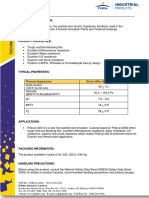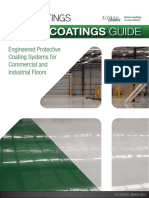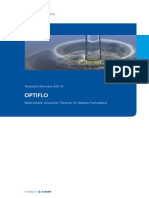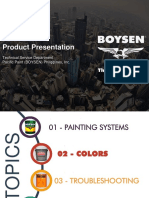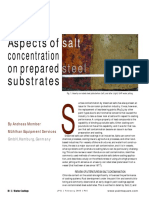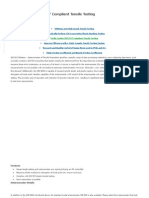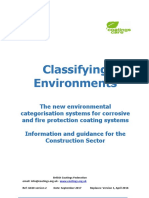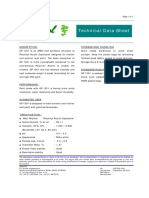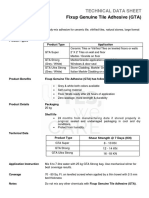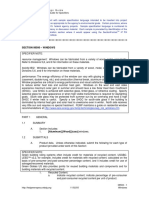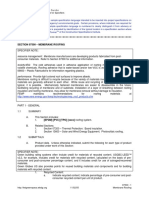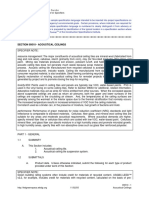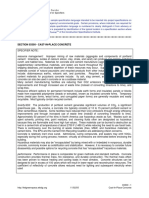Section 08210 - Wood Doors: Whole Building Design Guide Federal Green Construction Guide For Specifiers
Section 08210 - Wood Doors: Whole Building Design Guide Federal Green Construction Guide For Specifiers
Uploaded by
Anonymous NMytbMiDCopyright:
Available Formats
Section 08210 - Wood Doors: Whole Building Design Guide Federal Green Construction Guide For Specifiers
Section 08210 - Wood Doors: Whole Building Design Guide Federal Green Construction Guide For Specifiers
Uploaded by
Anonymous NMytbMiDOriginal Description:
Original Title
Copyright
Available Formats
Share this document
Did you find this document useful?
Is this content inappropriate?
Copyright:
Available Formats
Section 08210 - Wood Doors: Whole Building Design Guide Federal Green Construction Guide For Specifiers
Section 08210 - Wood Doors: Whole Building Design Guide Federal Green Construction Guide For Specifiers
Uploaded by
Anonymous NMytbMiDCopyright:
Available Formats
Whole Building Design Guide
Federal Green Construction Guide for Specifiers
This is a guidance document with sample specification language intended to be inserted into project
specifications on this subject as appropriate to the agency's environmental goals. Certain provisions, where
indicated, are required for U.S. federal agency projects. Sample specification language is numbered to
clearly distinguish it from advisory or discussion material. Each sample is preceded by identification of the
TM
of the
typical location in a specification section where it would appear using the SectionFormat
Construction Specifications Institute.
SECTION 08210 WOOD DOORS
SPECIFIER NOTE:
resource management: Refer to Division 6 for information on wood.
toxicity/IEQ: Refer to Division 6 for information on wood.
performance: Performance is comparable for green methods and standard methods.
PART 1
1.1
GENERAL
SUMMARY
A.
1.2
Section Includes:
1.
Solid-core doors with [wood-veneer] [medium-density
[hardboard] faces.
2.
Hollow-core doors with [wood-veneer] [hardboard] faces.
3.
Exterior stile and rail wood doors.
4.
Interior stile and rail wood doors.
overlay]
SUBMITTALS
A.
Product data. Unless otherwise indicated, submit the following for each type of
product provided under work of this Section:
SPECIFIER NOTE:
Specifying local materials may help minimize transportation impacts; however it may not have a
significant impact on reducing the overall embodied energy of a building material because of
efficiencies of scale in some modes of transportation.
Green building rating systems frequently include credit for local materials. Transportation impacts
include: fossil fuel consumption, air pollution, and labor.
USGBC-LEED v2.2 includes credits for materials extracted/harvested and manufactured within
a 500 mile radius from the project site. Green Globes US also provides points for materials that
are locally manufactured.
1.
Local/Regional Materials:
a.
Sourcing location(s): Indicate location of extraction, harvesting,
and recovery; indicate distance between extraction, harvesting,
and recovery and the project site.
b.
Manufacturing location(s): Indicate location of manufacturing
facility; indicate distance between manufacturing facility and the
project site.
c.
Product Value: Indicate dollar value of product containing
local/regional materials; include materials cost only.
http://fedgreenspecs.wbdg.org
11/02/05
08210 - 1
Wood Doors
Whole Building Design Guide
Federal Green Construction Guide for Specifiers
d.
Product Component(s) Value: Where product components are
sourced or manufactured in separate locations, provide location
information for each component. Indicate the percentage by
weight of each component per unit of product.
SPECIFIER NOTE:
Green building rating systems may include credit for low emitting materials. USGBC-LEED
v2.2, for example, includes credits for low-emitting materials, including: adhesives and sealants,
paints and coatings, carpets, and composite wood and agrifiber products. Under LEED v2.2,
adhesives and sealants are to comply with Californias South Coast Air Quality Management
District (SCAQMD) #1168; aerosol adhesives are to comply with Green Seal GS-36; interior
architectural paints are to comply with Green Seal GS-11; anti-corrosive paints are to comply with
Green Seal GS-03; clear wood finishes are to comply with SCAQMD #1113; carpet with the
Carpet and Rug Institute (CRI) Green Label Plus; carpet cushion with CRI Green Label program;
and, composite wood and agrifiber products are to contain no added urea-formaldehyde.
As per USGBC published Credit Interpretations, the credits for low-emitting materials are directed
towards interior, site-installed (i.e. not prefabricated) products. Verify project requirements for low
VOC products.
Both the Adhesive and Sealant Council (ASC) and the SCAQMD have indicated that low VOC
adhesives may have performance difficulties in extreme temperature and humidity conditions.
Green Seal, an independent, non-profit organization, certifies low-emitting products using
internationally recognized methods and procedures. Green Seal certification meets the criteria of
ISO 14020 and 14024, the environmental standards for ecolabeling set by the International
Organization for Standardization (ISO); the U.S. Environmental Protection Agency's criteria for
third-party certifiers of environmentally preferable products; and the criteria for bona fide
ecolabeling bodies of the Global Ecolabeling Network.
ANSI A208.1, the Composite Panel Associations Standard for Particleboard, includes maximum
formaldehyde emissions for different grades of particleboard; ANSI A208.2, the Composite Panel
Associations Standard for MDF, covers MDF for interior applications and includes maximum
formaldehyde emission level for different grades of MDF.
2.
VOC data:
a.
Adhesives for [site installation] [factory fabrication]:
1)
Submit manufacturers product data for adhesives.
Indicate VOC limits of the product. Submit MSDS
highlighting VOC limits.
2)
Submit Green Seal Certification to GS-36 and
description of the basis for certification.
3)
[Submit manufacturers certification that products
comply with SCAQMD #1168.] [
b.
Engineered Wood Products: Provide documentation that composite
wood and agrifiber products [are third-party certified as meeting
ANSI standard requirements for formaldehyde emissions] [contain
no added urea-formaldehyde resins.]
1)
ANSI A208.1 1999, Particleboard
2)
ANSI A208.2 2002, Medium Density Fiberboard (MDF)
for Interior Applications
SPECIFIER NOTE:
The 2002 Farm Bill - Section 9002, Federal Procurement Of Biobased Products, requires each
Federal Agency to develop a procurement program which will assure that items composed of
biobased products will be purchased to the maximum extent practicable and which is consistent
with applicable provisions of Federal procurement law.
USGBC-LEED v2.2 includes credits for use of rapidly renewable materials, which USGBC
describes as plants harvested within a ten-year cycle. Green Globes US, provides credit for
integration of materials from renewable sources that have been selected based on life-cycle
assessment.
http://fedgreenspecs.wbdg.org
11/02/05
08210 - 2
Wood Doors
Whole Building Design Guide
Federal Green Construction Guide for Specifiers
3.
Biobased materials:
a.
Indicate type of biobased material in product.
b.
Indicate the percentage of biobased content per unit of product.
c.
Indicate relative dollar value of biobased content product to total
dollar value of product included in project.
SPECIFIER NOTE:
USGBC-LEED v2.2 includes credit for use of sustainably harvested wood certified under Forest
Stewardship Council Guidelines. Under LEED v2.2, a minimum of 50 percent of wood-based
materials and products incorporated into the Project must be certified in accordance with the
Forest Stewardship Council Guidelines.
Green Globes US also provides points for wood products that originate from certified sources,
such as, Forest Stewardship Council, Sustainable Forestry Initiative, and the CSA Sustainable
Forest Management Program.
B.
Letter of Certification(s) for Sustainable Forestry:
1.
Forest Stewardship Council (FSC): Provide letter of certification signed
by lumber supplier. Indicate compliance with FSC "Principles for Natural
Forest Management" and identify certifying organization.
a.
Submit FSC certification numbers; identify each certified product
on a line-item basis.
b.
Submit copies of invoices bearing the FSC certification numbers.
2.
Sustainable Forestry Board: Provide letter of certification signed by
lumber supplier. Indicate compliance with the Sustainable Forestry
Boards "Sustainable Forestry Initiative" (SFI) and identify certifying
organization.
a.
Submit SFI certification numbers; identify each certified product
on a line-item basis.
b.
Submit copies of invoices bearing the SFI certification numbers.
3.
Canadian Standards Association (CSA): Provide letter of certification
signed by lumber supplier. Indicate compliance with the CSA and
identify certifying organization.
a.
Submit CSA certification numbers; identify each certified product
on a line-item basis.
b.
Submit copies of invoices bearing the CSA certification numbers.
C.
1.3
PART 2
2.1
Submit environmental data in accordance with Table 1 of ASTM E2129 for
products provided under work of this Section.
QUALITY ASSURANCE
A.
Sustainably Harvested Wood: Certification Organizations shall be accredited by
the [Forest Stewardship Council] [Sustainable Forestry Board] [Canadian
Standards Associations] [xxxxxxxx].
B.
Engineered Wood Products:
1.
Determine formaldehyde concentrations in air from wood products under
test conditions of temperature and relative humidity in accordance with
ASTM D6007 or E1333.
2.
Determine Volatile Organic Compounds VOC), excluding formaldehyde,
emitted from manufactured wood-based panels in accordance with
ASTM D6330.
PRODUCTS
MATERIALS
http://fedgreenspecs.wbdg.org
11/02/05
08210 - 3
Wood Doors
Whole Building Design Guide
Federal Green Construction Guide for Specifiers
2.2
A.
Lumber for Core, Stile and Rail, and Wood Veneer:
1.
Resource Management:
a.
Virgin Lumber: Lumber fabricated from old growth timber is not
permitted. Provide sustainably harvested; certified or labeled in
accordance with [FSC] [SFI] [CSA] [xxxxx] guidelines.
b.
Salvaged Lumber: Lumber from deconstruction or demolition of
existing buildings or structures.
Unless otherwise noted,
salvaged lumber shall be delivered clean, denailed, and free of
paint and finish materials, and other contamination.
c.
Recovered Lumber: Previously harvested lumber pulled from
riverbeds or otherwise abandoned. Unless otherwise noted,
recovered lumber shall be delivered clean and free of
contamination.
B.
Engineered Wood Products:
1.
Toxicity/IEQ:
a.
Products shall contain no added urea-formaldehyde.
ACCESSORIES
A.
2.3
Adhesives for [site installation] [factory fabrication]:
1.
Toxicity/IEQ: Comply with applicable regulations regarding toxic and
hazardous materials, GS-36 for Commercial Adhesive, [South Coast Air
Quality Management District Rule 1168] [, and as specified.
FABRICATED PRODUCTS
A.
Wood Doors:
SPECIFIER NOTE:
According to the June 7, 2002 Draft of the USDA Biobased Products Definitions and
Descriptions, minimum biobased content per item category might be defined as follows:
construction materials: 85 percent;
composite board: 70 percent;
landscaping materials: 100 percent;
compost: 100 percent;
adhesives: 80 percent;
furniture: can be designated as biobased products if 90 percent of all of the adhesives used in
the production are biobased adhesives.
For current designations under the Federal Biobased Products Preferred Procurement Program
(FB4P), refer to www.biobased.oce.usda.gov.
As of March 16, 2006, the Federal Register includes the final rule designating the first six items,
which are generic groupings of biobased products. The items are: mobile equipment hydraulic
fluids; biobased roof coatings; water tank coatings; diesel fuel additives; penetrating lubricants,
and; bedding, bed linens and towels. Refer to 7 CFR Part 2902, Designation of Biobased Items
for Federal Procurement; Final Rule. The requirements for purchasing biobased items apply to
those items directly purchased by the federal agency. Under a construction contract, the
contractor's use of hydraulic fluid in its bulldozers and backhoes is incidental to the purpose of its
contract, so the contractor is not required to use biobased hydraulic fluids. The Office of the
Federal Environmental Executive (OFEE) recommends that agencies encourage the use of these
items, however.
This is the first of a series of rules that will be issued designating biobased items. The USDA
currently has identified about 150 items for which it is collecting test data needed for the
additional designations of items that will extend preferred procurement status to include all
qualifying biobased products
1.
Biobased Content: Minimum [80] [85] [xxxx] percent biobased material.
http://fedgreenspecs.wbdg.org
11/02/05
08210 - 4
Wood Doors
Whole Building Design Guide
Federal Green Construction Guide for Specifiers
PART 3 - EXECUTION
3.X
SITE ENVIRONMENTAL PROCEDURES
A.
Indoor Air Quality:
1.
Temporary ventilation: Provide temporary ventilation during work of this
Section.
a.
During and immediately after installation of prefabricated wood
products, and laminated wood products at interior spaces,
provide temporary ventilation.
END OF SECTION
http://fedgreenspecs.wbdg.org
11/02/05
08210 - 5
Wood Doors
You might also like
- Microcement Step-By-Step - EN-1Document3 pagesMicrocement Step-By-Step - EN-1Eivind HolmNo ratings yet
- Chartek 8 Product Data SheetDocument4 pagesChartek 8 Product Data SheetJomer J Simpson0% (1)
- PRIMAL™ AC-365 Acrylic Emulsion: Regional Product Availability DescriptionDocument3 pagesPRIMAL™ AC-365 Acrylic Emulsion: Regional Product Availability DescriptionLong An ĐỗNo ratings yet
- GFRCDocument4 pagesGFRCrahulchandokNo ratings yet
- SECTION 09 91 00 PaintingDocument35 pagesSECTION 09 91 00 PaintingNiño Gabrielle VismonteNo ratings yet
- 099100-1 - Intumescent Fireproof CoatingDocument4 pages099100-1 - Intumescent Fireproof Coatinglink4biz1974No ratings yet
- 09 91 23 Painting, Staining, Coating & Finishing Rev 0Document12 pages09 91 23 Painting, Staining, Coating & Finishing Rev 0lalitha.saradha4No ratings yet
- Exolit AP 422Document3 pagesExolit AP 422محمد عزتNo ratings yet
- Jotamastic 87: Technical Data SheetDocument5 pagesJotamastic 87: Technical Data SheetMuhammad Fitransyah Syamsuar PutraNo ratings yet
- Raghucarbolinepresentations22122011 PDFDocument101 pagesRaghucarbolinepresentations22122011 PDFTanmay GorNo ratings yet
- TDS Pidicryl 326N PureDocument2 pagesTDS Pidicryl 326N PureLaura Isabel RodriguezNo ratings yet
- Reaction Paper - Davies PaintsDocument1 pageReaction Paper - Davies PaintsIan DalisayNo ratings yet
- AI Floor Coatings Guide WebDocument15 pagesAI Floor Coatings Guide WebSekson LapcharoensinNo ratings yet
- OlinDocument16 pagesOlinA AhmedNo ratings yet
- Fire Protective Coatings: Reinforced Passive Fire Protection by LapinusDocument18 pagesFire Protective Coatings: Reinforced Passive Fire Protection by LapinusHerbert Aguilargonzalez100% (2)
- Catalogue-KCC Epoxy PDFDocument49 pagesCatalogue-KCC Epoxy PDFTàiChínhDoanhNghiệpNo ratings yet
- Akzonobel AntifoulingDocument6 pagesAkzonobel AntifoulingshunanlatheefNo ratings yet
- BS 476-23-1987Document24 pagesBS 476-23-1987Hadi Iz'aanNo ratings yet
- Hardtop F15Document4 pagesHardtop F15Biju_PottayilNo ratings yet
- Spec of HR Black 600 DegreeDocument2 pagesSpec of HR Black 600 DegreeVijay DumbaliNo ratings yet
- Levasil Colloidal Silica Concrete Rheology ExternalDocument22 pagesLevasil Colloidal Silica Concrete Rheology ExternalA N MurthyNo ratings yet
- Hempel Book DecoDocument97 pagesHempel Book DecommkattaNo ratings yet
- Green Buildings PebsDocument15 pagesGreen Buildings Pebsenergymahesh2No ratings yet
- Crosslinker CX-100 Pds PDFDocument2 pagesCrosslinker CX-100 Pds PDFggudayakumarNo ratings yet
- FASTRACK Polymer EmulsionsDocument7 pagesFASTRACK Polymer EmulsionsVictor LopezNo ratings yet
- Optiflo: Technical Information B-RI 18Document8 pagesOptiflo: Technical Information B-RI 18Akshai RedwalkerNo ratings yet
- Henghe Materials (Catalogue)Document45 pagesHenghe Materials (Catalogue)juanrosonNo ratings yet
- Carboline BrochureDocument8 pagesCarboline BrochureSoumojit SamantaNo ratings yet
- Carboline Techy GuideDocument31 pagesCarboline Techy GuideAnnmNo ratings yet
- Hempelbookmpc Tank CnticDocument439 pagesHempelbookmpc Tank CnticHariandi Asril100% (1)
- Product Presentation: Technical Service Department Pacific Paint (BOYSEN) Philippines, IncDocument62 pagesProduct Presentation: Technical Service Department Pacific Paint (BOYSEN) Philippines, Incmark manalangNo ratings yet
- Guide To CuringDocument1 pageGuide To CuringTamer Gamil0% (1)
- Aspects of Salt Concentration On Prepared Steel SubstratesDocument6 pagesAspects of Salt Concentration On Prepared Steel Substratesmuthukumar100% (1)
- Pamphlet On Quality Assurance For Cement PlasteringDocument4 pagesPamphlet On Quality Assurance For Cement PlasteringD V BHASKARNo ratings yet
- Iso 527Document3 pagesIso 527Vo Truong GiangNo ratings yet
- Akfix Eng Technical Catalog 2022 Rev16Document211 pagesAkfix Eng Technical Catalog 2022 Rev16ahmed.serefNo ratings yet
- 1409-Presentation Rudolf Hensel GMBH and Audax Keck GMBH Gunther Kech AUDAXDocument58 pages1409-Presentation Rudolf Hensel GMBH and Audax Keck GMBH Gunther Kech AUDAXZaid Raslan AyoubNo ratings yet
- Phenoline 187 VOC PDSDocument2 pagesPhenoline 187 VOC PDSKhemaraj Path100% (1)
- TDS Screed 200-10F160807Document1 pageTDS Screed 200-10F160807Sean PnyktNo ratings yet
- Sealant PrimerDocument10 pagesSealant PrimerAlex BeldnerNo ratings yet
- Interchar 1260 Application Guidelines UkDocument18 pagesInterchar 1260 Application Guidelines UkMarkCanicula100% (1)
- Chemflake Brochure 2010 Tcm29 1582Document6 pagesChemflake Brochure 2010 Tcm29 1582jinyuan74No ratings yet
- IPG Structural Steelwork Paint Systems PDFDocument42 pagesIPG Structural Steelwork Paint Systems PDFAnonymous 5JWf1nS100% (2)
- Col.9 7671Document17 pagesCol.9 7671Thanh VuNo ratings yet
- Msds Jotamastic 80 A JotunDocument14 pagesMsds Jotamastic 80 A JotuncrysNo ratings yet
- G 020 Classifying Environments v2 Sept 2017Document8 pagesG 020 Classifying Environments v2 Sept 2017Nuno FerreiraNo ratings yet
- Al-Jazeera Firedamp 263Document2 pagesAl-Jazeera Firedamp 263EngTamer100% (1)
- Bitumen Modified With SBS Thermoplastic For Roofing ApplicationDocument9 pagesBitumen Modified With SBS Thermoplastic For Roofing ApplicationResearch and Development100% (1)
- TDS of GP 1301Document1 pageTDS of GP 1301APEX SONNo ratings yet
- Plastic Coatings: Advanced Polymer Technologies ForDocument13 pagesPlastic Coatings: Advanced Polymer Technologies ForFazlul HoqueNo ratings yet
- Epoxy ChalkingDocument2 pagesEpoxy Chalkingiran1362100% (1)
- Presentación de JOTUNDocument20 pagesPresentación de JOTUNNelson De la Cruz100% (1)
- Firepel K133 Series Polyester ResinDocument3 pagesFirepel K133 Series Polyester ResinShahzaib KhanNo ratings yet
- IPCM Protective Coatings Magazine 28 DecemberDocument76 pagesIPCM Protective Coatings Magazine 28 DecemberAbdul Rahman ObaidNo ratings yet
- Fixup Genuine Tile Adhesive (GTA) : Technical Data SheetDocument1 pageFixup Genuine Tile Adhesive (GTA) : Technical Data SheetkkNo ratings yet
- Guide Specifications For Portland Cement PlasterDocument5 pagesGuide Specifications For Portland Cement PlasterUmang sharmaNo ratings yet
- Masterseal TC 254 - TdsDocument2 pagesMasterseal TC 254 - TdsHanyNo ratings yet
- Nitoflor SL1000: Flow Applied, 0.5 - 1.5mm Thick Epoxy Resin Based Floor Topping UsesDocument4 pagesNitoflor SL1000: Flow Applied, 0.5 - 1.5mm Thick Epoxy Resin Based Floor Topping UsestalatzahoorNo ratings yet
- Section 08500 - Windows: Whole Building Design Guide Federal Green Construction Guide For SpecifiersDocument7 pagesSection 08500 - Windows: Whole Building Design Guide Federal Green Construction Guide For SpecifiersAnonymous NMytbMiDNo ratings yet
- DEER User's GuideDocument21 pagesDEER User's GuideAnonymous NMytbMiDNo ratings yet
- Section 09654 - Linoleum: Whole Building Design Guide Federal Green Construction Guide For SpecifiersDocument6 pagesSection 09654 - Linoleum: Whole Building Design Guide Federal Green Construction Guide For SpecifiersAnonymous NMytbMiDNo ratings yet
- Section 11450 - Residential Equipment: Whole Building Design Guide Federal Green Construction Guide For SpecifiersDocument4 pagesSection 11450 - Residential Equipment: Whole Building Design Guide Federal Green Construction Guide For SpecifiersAnonymous NMytbMiDNo ratings yet
- SECTION 09650 Resilient Flooring: Whole Building Design Guide Federal Green Construction Guide For SpecifiersDocument5 pagesSECTION 09650 Resilient Flooring: Whole Building Design Guide Federal Green Construction Guide For SpecifiersAnonymous NMytbMiDNo ratings yet
- Section 09250 - Gypsum Board: Whole Building Design Guide Federal Green Construction Guide For SpecifiersDocument3 pagesSection 09250 - Gypsum Board: Whole Building Design Guide Federal Green Construction Guide For SpecifiersAnonymous NMytbMiDNo ratings yet
- Section 12700 - Systems Furniture: Whole Building Design Guide Federal Green Construction Guide For SpecifiersDocument11 pagesSection 12700 - Systems Furniture: Whole Building Design Guide Federal Green Construction Guide For SpecifiersAnonymous NMytbMiDNo ratings yet
- Section 07500 - Membrane Roofing: Whole Building Design Guide Federal Green Construction Guide For SpecifiersDocument5 pagesSection 07500 - Membrane Roofing: Whole Building Design Guide Federal Green Construction Guide For SpecifiersAnonymous NMytbMiDNo ratings yet
- Section 08500 - Windows: Whole Building Design Guide Federal Green Construction Guide For SpecifiersDocument7 pagesSection 08500 - Windows: Whole Building Design Guide Federal Green Construction Guide For SpecifiersAnonymous NMytbMiDNo ratings yet
- Resource Management: toxicity/IEQ: Performance:: Section 10170 - Plastic Toilet CompartmentsDocument5 pagesResource Management: toxicity/IEQ: Performance:: Section 10170 - Plastic Toilet CompartmentsAnonymous NMytbMiDNo ratings yet
- Resource Management:: Section 11680 - Office EquipmentDocument4 pagesResource Management:: Section 11680 - Office EquipmentAnonymous NMytbMiDNo ratings yet
- Glass and EnergyDocument57 pagesGlass and EnergyAnonymous NMytbMiDNo ratings yet
- Section 09510 - Acoustical Ceilings: Whole Building Design Guide Federal Green Construction Guide For SpecifiersDocument5 pagesSection 09510 - Acoustical Ceilings: Whole Building Design Guide Federal Green Construction Guide For SpecifiersAnonymous NMytbMiDNo ratings yet
- Section 03300 - Cast-In-Place Concrete: Whole Building Design Guide Federal Green Construction Guide For SpecifiersDocument7 pagesSection 03300 - Cast-In-Place Concrete: Whole Building Design Guide Federal Green Construction Guide For SpecifiersAnonymous NMytbMiDNo ratings yet











